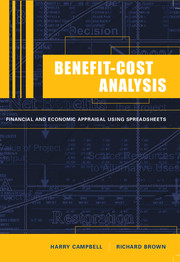Book contents
- Frontmatter
- Contents
- List of figures
- List of tables
- Preface
- Acknowledgements
- 1 Benefit-Cost Analysis: Introduction and Overview
- 2 Investment Appraisal: Principles
- 3 Investment Appraisal: Decision-Rules
- 4 Private Benefit-Cost Analysis: Financial Analysis
- 5 Efficiency Benefit-Cost Analysis
- 6 Calculating the Net Benefits to the Referent Group
- 7 Consumer and Producer Surplus in Benefit-Cost Analysis
- 8 Valuing Traded and Non-traded Commodities in Benefit-Cost Analysis
- 9 Incorporating Risk in Benefit-Cost Analysis
- 10 The Social Discount Rate, Cost of Public Funds, and the Value of Information
- 11 Weighting Net Benefits to Account for Income Distribution
- 12 Valuation of Non-marketed Goods
- 13 Economic Impact Analysis
- 14 Writing the Benefit-Cost Analysis Report
- Appendix 1 Case Study Assignment
- Appendix 2 Discount and Annuity Tables
- Index
6 - Calculating the Net Benefits to the Referent Group
Published online by Cambridge University Press: 05 September 2012
- Frontmatter
- Contents
- List of figures
- List of tables
- Preface
- Acknowledgements
- 1 Benefit-Cost Analysis: Introduction and Overview
- 2 Investment Appraisal: Principles
- 3 Investment Appraisal: Decision-Rules
- 4 Private Benefit-Cost Analysis: Financial Analysis
- 5 Efficiency Benefit-Cost Analysis
- 6 Calculating the Net Benefits to the Referent Group
- 7 Consumer and Producer Surplus in Benefit-Cost Analysis
- 8 Valuing Traded and Non-traded Commodities in Benefit-Cost Analysis
- 9 Incorporating Risk in Benefit-Cost Analysis
- 10 The Social Discount Rate, Cost of Public Funds, and the Value of Information
- 11 Weighting Net Benefits to Account for Income Distribution
- 12 Valuation of Non-marketed Goods
- 13 Economic Impact Analysis
- 14 Writing the Benefit-Cost Analysis Report
- Appendix 1 Case Study Assignment
- Appendix 2 Discount and Annuity Tables
- Index
Summary
Introduction
The referent group in a social benefit-cost analysis is unlikely to consist only of the equity holders of the private firm, at one extreme, or everyone affected by the project in the whole world, at the other extreme. The costs and benefits to the former group were analysed in Chapter 4, and those to the latter group in Chapter 5. In this Chapter we analyse the costs and benefits to the referent group. Our client will tell us what the referent group is, and she will normally nominate all groups affected by the project (sometimes referred to as “stakeholders”) who are resident in her State or country, including effects on government receipts or payments: in the ICP Case Study discussed in the Appendices, “Thailand” is the referent group.
As noted in Chapter 1 it is sometimes easier to specify who is not a member of the referent group than to identify all the relevant sub-groups; in the ICP Case Study, of those groups who benefit or incur costs, the foreign equity holders in the firm and the foreign financial institution which lends to the project are not members of the referent group. This means that the aggregate net benefits to the referent group can be calculated by subtracting the net cash flows experienced by these two groups from the efficiency net benefits of the project discussed in Chapter 5. Thus we can open Part 5 of our spreadsheet mdash; the Referent Group Benefit-Cost Account mdash; by entering the efficiency net benefits row less the equity holder's and foreign financial institution's net benefit rows. (See Figure A6.2, Table 5, row 4, page 142.)
Information
- Type
- Chapter
- Information
- Benefit-Cost AnalysisFinancial and Economic Appraisal using Spreadsheets, pp. 122 - 145Publisher: Cambridge University PressPrint publication year: 2003
